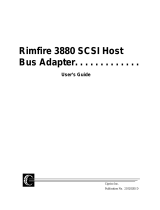
viii
Switches..............................................................................................................2-3
ABT (S1).....................................................................................................2-3
RST (S2)......................................................................................................2-3
Front Panel Indicators (DS1 – DS4)...................................................................2-4
BFL (DS1)...................................................................................................2-4
CPU (DS2)..................................................................................................2-4
PMC2 (DS3)................................................................................................2-4
PMC1 (DS4)................................................................................................2-4
10/100BaseT Port...............................................................................................2-5
DEBUG Port.......................................................................................................2-5
PMC Slots...........................................................................................................2-7
PCI MEZZANINE CARD (PMC Slot 1)....................................................2-7
PCI MEZZANINE CARD (PMC Slot 2)....................................................2-7
PMCspan ...................................................................................................................2-8
CHAPTER 3 Functional Description
Introduction ...............................................................................................................3-1
Features......................................................................................................................3-1
General Description...................................................................................................3-3
Block Diagram...........................................................................................................3-3
MPC750 Processor.............................................................................................3-5
L2 Cache .....................................................................................................3-5
Hawk System Memory Controller (SMC)/PCI Host Bridge (PHB) ASIC........3-6
PCI Bus Latency .........................................................................................3-7
PPC Bus Latency.........................................................................................3-9
Assumptions..............................................................................................3-11
Clock Ratios and Operating Frequencies..................................................3-11
PPC60x Originated....................................................................................3-11
PCI Originated ..........................................................................................3-12
SDRAM Memory.............................................................................................3-12
SDRAM Latency.......................................................................................3-13
Flash Memory...................................................................................................3-16
ROM/Flash Performance ..........................................................................3-17
Ethernet Interface.............................................................................................3-19
PCI Mezzanine Card (PMC) Interface.............................................................3-20
PMC Slot 1 (Single-Width PMC) .............................................................3-21
PMC Slot 2 (Single-Width PMC) .............................................................3-21
PMC Slots 1 and 2 (Double-Width PMC) ................................................3-22
PCI Expansion...........................................................................................3-22
VMEbus Interface ............................................................................................3-22




















